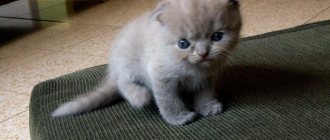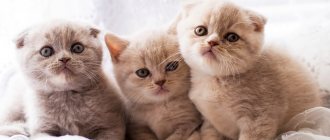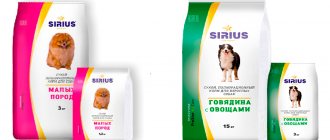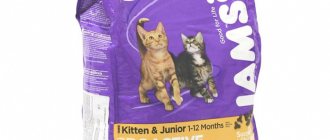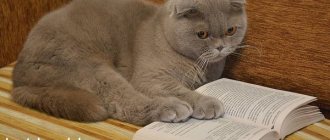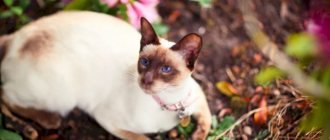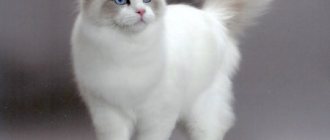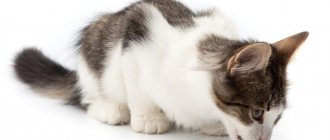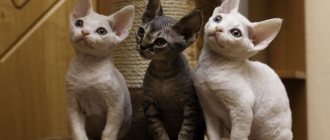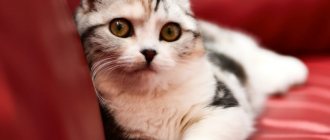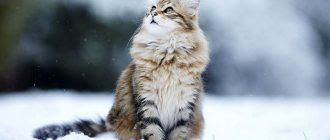If you came to this page because you want to find a forum for Scottish cats, join our community on Facebook, where we discuss all the current issues about the breed and cats in general. And in this publication below you will see reviews about the Scottish breed. Before getting a Scottish kitten, many people prefer to read reviews from owners.
Below we have collected typical opinions, both positive and negative. Our selection contains approximately equal amounts of positive and negative, but don’t let this confuse you. In fact, if you look around the Internet, you will find much more positive reviews about Scottish dogs than negative ones: the ratio is approximately 80% to 20%. Our selection is intended to reveal some of the characteristic problems and behavioral features of Scottish cats, for which future owners should be prepared, so there are an equal number of reviews.
Article continues after advertisement
History of the breed
This breed has a long and very interesting history, which begins in the eighteenth century. Scottish cats originate from a wild cat that lived in the mountains. In the process of working on the breed, breeders infused the blood of wild animals into domestic cats, with the goal of obtaining a bright and strong livestock. At different stages of selection, to improve the quality of wool and expand the range of colors, the blood of the British and Persians was infused into Scottish cats.
The unusual, curved shape of the ears became an exclusive feature of the Scottish breed, giving the cats a special charm. The Scots immediately attracted attention and became in demand; The first mentions of them appeared more than two hundred years ago. But within the breed there are not only fold-eared individuals (folds), but also cats with ordinary, straight ears (straights), which in no way reduces the merits of these animals or the interest in them.
Folds and straights are siblings
A variety of Scots with straight ears and a very beautiful coat, soft and flowing, is separated into a separate breed, which is called the Highland Straight and still remains quite rare. This is a fairly young breed that received official recognition only in 1970.
Temperament
The Scottish Straight personality is known for its sociability. It is well suited to large families and welcomes the presence of both other people and other cats. He loves to be flattered and pampered, he always lacks attention.
Its lively and curious character makes this cat suitable for those with children. He will always be cheerful and playful and will love communication more than anything else. He is extremely affectionate, calm and with a strong mind.
- Like most cats, the Scottish Straight is well suited for apartment life.
- This lively and curious feline loves to interact with others and, above all, has a strong investigative instinct.
Uncontrollable curiosity will push him to explore every corner of the house without stopping, so it is necessary to purchase toys from the first days and install a scratching post to avoid peeling wallpaper and flying off cornices. This does not require much effort, but the cat will have everything it needs - the opportunity to express itself and have fun.
Description of Highland Straight cats
The Scottish breed includes four varieties of cats. Scots can be either shorthaired or semi-longhaired; both short-eared and straight-eared . They all have the same breed requirements and characteristics - the only difference is in the shape and placement of the ears. You can see some similarities between the straight-eared Scots and the British, but upon closer examination it becomes clear: these are completely different breeds, differing in many ways both in appearance and in behavioral characteristics.
Highland Straight - an aristocrat of the cat world
However, even within the large and popular Scottish breed, Highland Straights stand somewhat apart - these are very interesting cats, and it is no coincidence that the owners of this breed become its ardent fans forever.
Their noble Scottish origin is felt in everything - from the nuances of appearance to every movement. Highland straights are unusually elegant and aristocratic, but at the same time they are not snobs or arrogant at all, but very nice, good-natured and sociable guys.
External data
Cats of this breed have medium dimensions: the weight of an adult individual reaches six kilograms, and the height is thirty centimeters at the withers. The body is strong, strong, with wide bones and a pronounced topline. The tail is quite long, fluffy and flexible - if desired, you can easily wrap it in several rings around your finger, and the cat will not experience any discomfort from this. The head is round, the ears are small, erect, slightly rounded at the top - they should be evenly covered with hair of the same length.
Highland Straight is a strong and harmonious cat
A huge number of colors are allowed in the breed, but according to the standard, the color of the animal’s eyes must match the color of its coat. Emerald green eyes are considered normal for silver and gold colors. “Sweet eye expression” is even officially included in the standard as an integral feature of the breed.
The breed standard notes the cute expression in the eyes of these cats
The undoubted advantage of Highland Straights is their luxurious coat - there is a lot of it, it is beautiful and pleasant to the touch, but, unlike the same Persians, it does not tangle or tangle to such a state that it is easier to shave than to comb.
Video: Scottish cats with straight ears
Character and behavior
The character of the Scots is simply impossible not to like. The breed is absolutely non-aggressive and self-sufficient. These cats will not suffer from loneliness in the absence of the owner - they will fall into depression or, conversely, destroy the house from melancholy and sadness. At the same time, attachment to the owner and interest in him are very high. Straights are sociable and sociable, communicate well with children, do not conflict with other pets, are not afraid of strangers, and generally behave with great dignity.
Highland Straights are famous for their balanced nervous system, although no one would dare to call these inquisitive and playful cats phlegmatic. They are very interested in everything that the owner is doing, but they will never “stick” to him, impose their company, demand love and affection. Just as they won’t raise their voices without unnecessary need. They are generally not very talkative - it seems that their life principle is to meow only on business, for example, when it is finally time to have dinner.
They adapt surprisingly easily to new places and circumstances, willingly setting out on independent research. Independence and self-esteem are the “family” character traits of a straight man. Don’t even try to break his independent nature with pressure and force - this aristocratic cat will never be able to understand such brutality towards himself and will lose all respect for his owner. Yes, they are touchy - but not vindictive: having been disappointed in a person, they will not shit in his slippers, they will simply ignore him.
Video: Highland Straight - a cat with whom you feel comfortable
Character
Scottish Straights are distinguished by their flexible character. They are very smart and not aggressive. Cats quickly become attached to the house and to their owners, having chosen one favorite. They do not like to be left alone and, if possible, are not averse to jumping into a person’s arms. At the same time, they will not impose their company if they see that the owner is not inclined to communicate.
New people in the house do not scare them, although sometimes cats want to be sad alone, then they climb into a quiet place. The voice of the Scottish Straight can not be heard often, they do not hysteria, do not meow loudly, except when begging for a treat.
The owner does not have to worry about the safety of the furniture and the cleanliness of the carpet: “Scottish dogs” are very clean and polite, they quickly get used to the tray and scratching post and indifferently walk past the soft sofa without putting their claws into it.
Straight-eared “Scots” easily get along with children and other animals, without showing any aggression or jealousy. They easily tolerate moving, changing home, familiar surroundings, and if due to circumstances they are forced to change owners, they quickly adapt to the new environment.
In a word, cats of this breed can be called ideal. The main thing is that there is food in the bowl and favorite toys on the rug.
Buying a kitten
The decision to purchase a Highland Straight kitten is an excellent choice for both a single person and a large family. Cats of this breed are ideal, almost problem-free companions. It can be difficult for a non-specialist to distinguish a truly purebred little Straight from just a fluffy baby, which is often taken advantage of by scammers.
Do not buy a kitten at the poultry market - you risk acquiring not only a mongrel, but also a sick animal. Trust your choice to one of the Highland Straight breeding nurseries - professional breeders value their reputation. Don’t choose your future pet based on a photograph, find an opportunity to go get it yourself, or even better, ask a breed specialist for help in choosing it.
Invite the breeder to show you not only the pre-selected kitten, but also its parents, brothers and sisters. The litter should contain both fold-eared and straight-eared babies - this is the first sign that you are acquiring a truly thoroughbred longhaired Scotsman.
The breed has a huge variety of colors
Criterias of choice
You should purchase a kitten at three months of age, no earlier - by this time the breeder will have already given the necessary vaccinations, and also determined the main breed qualities of the animal. Be prepared for the fact that a small show-class Highland Straight costs an order of magnitude more than a pet. The main selection criteria should be the health and behavior of the baby - pay attention to the following external factors:
- eyes - clear, not sour;
- ears - clean, not inflamed;
- the coat is shiny and well-groomed;
- the tummy is well-fed, but not bloated.
When meeting for the first time, the baby’s behavior can tell a lot - he should be cheerful, sociable and active, and not be afraid of a stranger. It is worth taking a closer look at the parents of your future pet - their appearance, character, living conditions.
Video: kittens who love to play
Maintenance and care of Highlands
Highland straights do not create any special maintenance difficulties for their owner. The breed is quite unpretentious, but compliance with the basic rules of caring for the animal is, of course, necessary.
Feeding
A proper diet is very important for the health and longevity of this breed. Highland Straights have a good appetite and unpretentiousness in food, but they are prone to overeating. This feature, with poorly organized feeding and limited exercise, can lead to obesity of the animal.
Highland straights love to eat hearty food
Your pet's meals should be divided - from two to four times a day - and balanced; choose high-quality super-premium food for him and never overfeed him. If you prefer natural food, discuss the menu with the kitten’s breeder - it is very important that he receives the required amount of vitamins and minerals, especially during the growing period.
Adequate physical activity won’t hurt either - Highland Straights are happy to walk on a leash . And if active outdoor games at home are added to such regular exercise, your pet will not be at risk of obesity.
Appearance care
If you don't want all the surfaces in the house, and at the same time your clothes, to be covered with a layer of weightless cat fluff, pay close attention to your pet's fur during the molting period. First of all, this applies, of course, to semi-longhaired cats. At this time, daily combing should become a mandatory hygiene procedure. One slicker brush will probably not be enough - the furminator helps get rid of the soft, dying undercoat perfectly.
If a cat is accustomed to brushing from an early age, then she tolerates it calmly and patiently. But it is up to the owner not to allow the shedding fur to become “felt felt” - in this sad case, the procedure will become unpleasant and even painful, and the cat will try with all his might to avoid it. However, you have to try very hard to get the Straight's fur to become very matted - in this breed it is very soft, silky and practically does not tangle.
A good furminator is very effective during the molting period.
As usual, one brushing a week is enough to keep your pet looking pretty good. Particular attention should be paid to those places where the hair is longer and thicker: pants, bellies, a beautiful collar. The whole procedure will take you no more than half an hour.
Frequent bathing is also not for this breed - thorough washing with shampoo and other cosmetics will only be needed a couple of times a year, and also in cases of unpredictable contamination - this happens to everyone. The rest of the time, the neat cat takes excellent care of herself, and she absolutely does not need the owner’s help in this.
It would be a shame not to keep such fur in perfect condition.
In winter or after a too hot summer, it makes sense to nourish the fur that has lost its elasticity with special conditioners containing healing oils. Just don’t do this on the eve of the exhibition - the fur coat will briefly lose its ceremonial appearance after such an undoubtedly useful event.
But it definitely won’t hurt to check the condition of the eyes, ears, teeth and claws at least once a week. Carry out the usual cleaning procedures, trim overgrown claws if necessary - that’s all the wisdom of caring for this breed.
Raising Scottish Straight
You should start raising a small kitten immediately after purchasing it. But this must be done gradually and carefully, without haste. Kids are quite capricious and touchy, so you will have to be patient. At first, kittens show excessive obstinacy and hyperactivity, but over time they become calm and balanced. Straights get accustomed to the litter tray quite quickly. You should never swear or scream at a kitten, much less spank it. Such upbringing will not lead to anything good.
Breed defects
Since the breed is quite young and not numerous, its gene pool is limited, and if the rules of breeding are violated, both hereditary health problems and some phenotypic deviations from the standard can arise.
Tendency to diseases
Straight-eared Scottish cats are distinguished by enviable health and, if kept in good conditions, live up to twenty years without problems. The main problems can be various anomalies of bones and joints, caused by both poor heredity and improper cultivation.
The basis of most of these ailments is often a genetic pathology, fixed in the process of illiterate or unscrupulous breeding work. Unfortunately, such diseases can rarely be completely cured. However, the sooner they are diagnosed, the higher the likelihood of maintaining the animal in normal physical shape.
A common breed problem is poor mobility of the spinal joints. Show experts pay special attention to the cat's topline when moving: it should be level and stable. A cat can be removed from the show if its joints crack or squeak - this is considered a disqualifying fault, indicating poor genetics - such animals should not be bred.
Among the breed diseases of Straights there is even dysplasia of the hip and elbow joints - a pathology that is generally extremely rare in cats. A reliable diagnosis of the disease is provided by correctly taken x-rays of an animal that has reached one year of age. The veterinarian will prescribe treatment or supportive care depending on the degree of dysplasia. In some difficult cases, surgical intervention is indicated.
The consequence of an unbalanced, too abundant and high-calorie diet is obesity characteristic of the breed and associated diseases of the cardiovascular system.
Flaws in appearance
The breed standard pays special attention to the Straight's ears - they should not be large or even slightly sagging. Such shortcomings automatically prevent the animal from participating in the exhibition, and therefore in breeding. A serious drawback is considered to be “wadding”, matting and tangling hair, as well as long tufts of it on the eyebrows or other parts of the head. Cats with any abnormalities in the structure of the bones or joints will not receive high expert ratings; weighted animals.
Disqualifying faults include a tail that is too short and stiff, a hook at its tip, and an unusual number of toes on the paws. The animal must be healthy and move easily and harmoniously.
Video: Highland Straight kitten at an exhibition
Appearance
Since 2005, the Scottish Straight breed (variant names - Scottish Straight, Scottish Shorthair, SCS coding) has been recognized in the official felinological organizations: World Cat Federation (WCF), Cat Fanciers Association (CFA), International Cat Association (TICA).
Breed standard:
- Body: medium size, rounded lines, evenly developed at the level of the shoulders and croup.
- Legs of medium length. Paws are rounded.
- Head: Beautifully rounded, with a strong chin and developed jaws. Muzzle with rounded whisker pads. The nose is short with a slight depression at the transition from the forehead; a “stop” (sharp angle) is undesirable. The profile line may vary. The neck is short.
- Eyes: wide open, large, well rounded, fairly widely spaced.
- Ears: Small to medium in size, set wide apart, open forward, tips rounded, outer lines parallel. The ears should be set so as to emphasize the rounded skull.
- Tail: Medium to long in relation to the body, pointed towards the tip.
- Coat: short, dense, plush, soft, non-lying (lags behind the body due to density). Regional and seasonal slight variations in coat texture are possible.
- Color: any colors are allowed.
- Disqualification: hooked tail, extremely short, immovable tail, overbite.
When breeding the Scottish Fold breed (and, accordingly, the Scottish Straight as its side branch), breeders most often used British, as well as Persian and exotic cats. As a result, strites of various “modifications” appeared:
- with wide ears, massive bones, short tail, heavy and squat - from mating with the British;
- with a shortened nose, with a clear sharp transition from the nose to the forehead (“stop”) - a legacy of exotic producers;
- with long, close-lying hair and an incorrect bite - “Persian-type” Straights.
Individuals that deviate from the recognized standard are excluded from breeding.
Differences between British and Scottish cats
Historically, the Scots and the British developed in neighboring territories, so they are similar to each other, like close relatives. It’s funny that the British is the oldest officially registered breed in the world, and the Scottish is the youngest.
On the left is a Scottish Straight cat, on the right is a British Shorthair
Unscrupulous breeders take advantage of the similarity of breeds in order to sell a British Straight or a “half-breed” to an inexperienced buyer. Of course, when choosing a kitten, you should always contact trusted nurseries or owners, look at reviews and check certificates, but knowing the main distinguishing features of the two breeds is also useful.
Table: differences between the Scots and the British
| Parameter | British shorthair cat | Scottish straight cat |
| Muzzle | Dense, “stuffed” cheeks, developed cheekbones, the head is shaped like a horizontal oval | Round cheeks, developed chin, head shape - perfectly round |
| Ears | Wide at the base, low set, spread out to the sides | Narrower and straighter |
| Body | Powerful, strong-boned, stocky. The paws are thick and short. | Average, more elegant. The legs are slender and long in comparison with the body. |
| Wool | Dense, with a thick undercoat, short | Thick, plush to the touch, short or long |
| Tail | Thick, short, inflexible, uniform in thickness, rounded tip | Long, flexible, wide at the base and narrow at the end, pointed tip |
| Weight | Cat 5–8 kg Cat 3–5 kg | Cat 3–5 kg Cat 2–3 kg |
The difference between the face of a British cat (left) and a Scottish cat (right)
Disadvantages of the breed
When crossing two lop-eared sires, the offspring received genetic mutations associated with insufficient development of cartilage tissue. Their signs can also appear in ordinary Straight offspring, since any Scottish cat carries in its gene set the recessive gene for lop-earedness, and, consequently, the diseases associated with this external trait.
A fixed, inflexible tail, the most noticeable sign of this mutation, is a serious fault. Another result of this mutation is fused and deformed vertebrae, which is why the cat cannot jump high and, as it grows up, begins to walk “half sideways.” Some back problems are noticeable even at the age of 3–4 months, when kittens are weaned from their mother, while others are detected already in adulthood.
You can avoid defects and long-term treatment for your pet if you take a kitten with good characteristics and pedigree from a trusted breeder.
Scottish Straight colors
In color, the breed resembles its British relatives. Most felinological associations accept any color. The exception is the Cat Fanciers Association - the CFA does not allow chocolate, lilac shades, colorpoint and their variations with white.
The most common colors are:
- Solid - solid. It is assumed that the color of the coat will be monochromatic, without interspersing other colors. Classic blue is the most popular and common color among both breeders and owners. Less common are black, purple, red (red), brown and white.
- Tabby. With the light hand of cat food advertisers, this color is popularly called “whiskas” - a characteristic “M” on the forehead, contrasting spots on the body. Tabby color can be brindle (transverse stripes on the sides), spotted (several parallel stripes along the back, spots on the sides and chest - several closed stripes), marbled (half rings or streaks on the sides and along the back).
- Tortoiseshell color - spots of cream, gray, red or white are randomly scattered on a black background (primary color).
Photo gallery: examples of the color of the Scottish Straight breed
The unusual arrangement of differently colored zones is a distinctive feature of the tortoiseshell color
Lilac is a fairly rare solid color variety.
Chocolate is a very rare color; show kittens can cost up to 100 thousand rubles
The classic color option - blue - is the most popular among breeders and owners
Tabby color straights look very attractive
Breeding work with Highland Straights
Strict breeding rules prohibit the breeding of two Scottish Fold cats. The parent pair always consists of a straight and a fold, therefore, in one litter of Scottish cats, both straights and folds are necessarily born. There is an unprofessional opinion that the Scots are still infused with the blood of the British breed - but this is nothing more than a myth.
Nuances of breeding
Folds should absolutely not be bred with folds, because as a result genetic abnormalities occur that are fraught with serious problems with the musculoskeletal system and pathologies of internal organs. Mixed pairs “fold+straight” are the only competent way of intrabreeding work.
Representatives of this breed have heavy bones, take a long time to form, and complete puberty occurs quite late in them. Therefore, it is recommended not to make the first mating before the animals reach two years of age; A cat should not give birth more than once a year.
Castration or sterilization of Highland Straights is done both for medical reasons and at the request of the breeder, who wants to receive confirmation that the animal will not be used for breeding. Surgery is usually performed on male and female cats after eight months of age.
There will definitely be both folds and straights in one litter
Interestingly, the most magnificent coats are obtained from the union of a long-haired Straight with a short-haired one - if the latter has the long-haired gene.
It will probably be possible to judge which of the kittens in the litter have straight ears and which have floppy ears only when the babies reach a month or at least three weeks of age. All newborn kittens have straight ears, and remain so for some time.
Diseases of straight-eared Scots
Like any breed, Scottish dogs have several characteristic diseases that are transmitted at the genetic level.
Only a specialist can make a correct diagnosis; self-medication often causes irreparable harm
Genetic diseases
Predisposition to certain diseases is inherited. Of course, it is not at all necessary that the cat will get sick, but the probability of this is quite high.
Osteochondrodysplasia (OCD)
When breeding lop-eared offspring, folds are crossed with straights, then the “loop-eared” gene manifests itself in the first generation only as a fold on the ears of some of the offspring. It affects the formation of cartilage tissue throughout the body, and kittens (both Straights and Folds) may appear with mutations in the bones and spine.
As a rule, such deviations are the result of unscrupulous work by breeders in breeding Scottish Folds, when two fold-eared individuals are crossed. Litters produce a large number of kittens with folded ears, and all of them begin to suffer from OCD as they age.
When buying a Scotsman, you need to be careful when choosing a nursery or individual breeder, find out whether a genetic test has been done to determine the likelihood of OCD.
Sometimes the pathology is immediately visible by the immobility of the tail, arching in the back and awkward movements of the animal. Kittens jump heavily, often fall, and sometimes even refuse to jump on high objects. And sometimes the mutation manifests itself in adulthood, when the pet has been living in the family for a long time. Unfortunately, it is not possible to cure such disorders, and the owners can only choose a diet that prevents further deterioration of the Straight’s well-being and come to terms with some restrictions.
Animals are prescribed chondroprotectors; if movement is painful, non-steroidal anti-inflammatory drugs and painkillers are prescribed. Massage can have a good effect. In severe cases, surgery is prescribed.
Cats with OCD need proper nutrition containing phosphorus, calcium, iodine, iron, and vitamins E. Such animals are sedentary, and owners need to strictly control their weight, because obesity threatens heart disease, and extra pounds place excess stress on damaged joints.
Urolithiasis (UCD)
Cats, like people, can suffer from urolithiasis. In 25% of cases, the disease affects castrated cats; in unsterilized males and females it occurs in approximately 4-6 cases out of 100.
General conditions affecting the occurrence of urolithiasis are:
- male gender (in cats the disease develops 5 times more often than in cats);
- unbalanced diet using salty foods and an excess of proteins in it;
- feeding with cheap factory feed;
- insufficient fluid intake (as a result, the urine becomes too concentrated and sand forms in it);
- drinking low quality water saturated with lime salts;
- hereditary predisposition;
- urinary tract infections;
- dysfunction of the gastrointestinal tract, chronic gastroenteritis and colitis (these diseases change the acid-base balance of urine, which can lead to the formation of stones);
- deliberate retention of urination by a cat due to reluctance to go into a dirty litter box (this is why it is so important to clean the toilet on time).
KSD can develop unnoticed over several years, or it can quickly develop into an acute phase. The cat shows anxiety when visiting the toilet, meows pitifully, the frequency of urination increases or urinary retention is detected, and blood appears in the tray. If one or more signs are detected, you should immediately contact your veterinarian.
The owner can suspect urolithiasis in a pet by its posture during urination
Treatment of urolithiasis is comprehensive:
- At the first stage, it is necessary to relieve spasm and reduce pain; for this, warm heating pads (carefully placed on the stomach and perineum) and antispasmodics are used.
- Next, the doctor prescribes drugs that dissolve and remove stones and sand.
- In the future, the animal needs a constant diet, which reduces the risk of re-exacerbation.
Cardiomyopathy
The most common heart pathology is hypertrophic cardiomyopathy (HCM); in addition to Scottish cats, British, Maine Coon, Sphynx, Ragdoll and Norwegian forest cats are also susceptible to it. Thickening of the heart muscle (myocardium) leads to the development of heart failure, blood stagnation, pulmonary edema and, as a result, death.
In hypertrophic cardiomyopathy, the heart muscle thickens, making it difficult for the organ to function.
This disease is extremely insidious. Sometimes the first sign is pulmonary edema, which leads to the death of the animal within a few hours. In milder cases, lethargy and shortness of breath appear, the animal cannot play for a long time, often interrupts and rests, and breathes with an open mouth.
Veterinarians have found that the disease is hereditary in nature, and only producers who do not have a predisposition to HCM are allowed to breed abroad. This can be determined using a special blood test, as well as the results of echocardiography and electrocardiography. The diagnosis of the animal is also made on the basis of these studies.
Finding out the predisposition or hidden course of the disease is extremely important for maintaining the health of the cat. In European countries, animals from risk breeds undergo annual electrocardiography, which is marked in the passport. It is also legally prohibited to use individuals for breeding that have not confirmed the absence of the disease. Unfortunately, in our country such rules and regulations do not exist, which is why it is important to carefully choose the breeder of your straight and study reviews of previously purchased animals.
Common signs of feeling unwell
Even domestic cats that do not leave the apartment can get sick. Straits, of course, have good immunity, but no one is immune from infections that owners can bring along with dust on shoes and outerwear, from colds and parasites.
That is why you need to know the main symptoms of poor health of your tailed friend:
- change in habitual behavior - the cat avoids communication, hides in secluded dark places;
- refusal to eat for more than 2 days;
- increased body temperature, trembling, fever;
- sneezing, discharge from the eyes, nose, excessive salivation;
- lack of stool, blood in feces, diarrhea;
- vomit;
- loss of a large amount of hair, its dull appearance;
- bad breath.
The appearance of one or more symptoms is a reason to immediately contact a veterinarian. Only a doctor can make the correct diagnosis and prescribe the correct treatment. An attempt at self-diagnosis leads, at best, to the futility of treatment measures, and at worst, the disease takes on a more severe form.
Disease Prevention
Vaccines have been developed for most dangerous cat diseases.
Kittens receive the first set of vaccinations against rhinotracheitis, calcivirus and panleukopenia at the age of 8-9 weeks, 3-4 weeks after that they undergo revaccination and receive another vaccination against rabies.
Kittens at the age of 3 months (remember, the age when babies can be painlessly weaned from their mother) from good breeders should have a record of vaccinations in their veterinary passport. The absence of these indicates the seller’s dishonesty; buying unvaccinated kittens is extremely undesirable.
Vaccinations reduce the risk of disease by up to 90%, they are necessary to protect your streak
Table: pros and cons of the breed
| Advantages of the breed | Disadvantages of the breed |
| Endowed with beautiful appearance and balanced character | They cannot stand pressure from the owner, they are touchy and vulnerable |
| Smart, trainable, clean | Genetically prone to pathologies of the musculoskeletal system |
| Good with children and pets | Poor diet can lead to obesity |
| Good health and stable immunity | Poorly tolerate heat and excessive dry air |
| Easy maintenance and care of the coat | The breed is difficult to breed |
Breeding Scottish Straight
Breeding a Scottish Straight should begin with choosing a suitable pair for a female cat. Scottish breeds have always been prone to the presence of genetic diseases, so the selection of individuals for breeding should not be underestimated.
- Having two Scottish cats with genetic abnormalities can lead to congenital osteochondrodysplasia.
- Therefore, it is advisable to combine the Scottish fold with the Scottish straight to avoid this problem.
In special cases, if the parents are of high cost, it is worth conducting a DNA test and if the result is negative for the presence of errors in the genome, you can begin mating and gestation. Well, it’s worth feeding the expectant mother with premium food so that the Scottish Straight kittens turn out strong and healthy.
